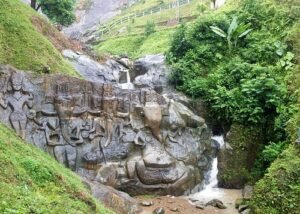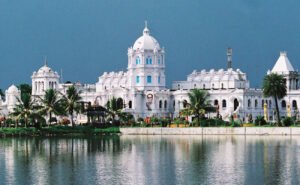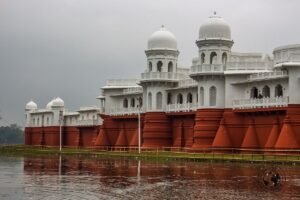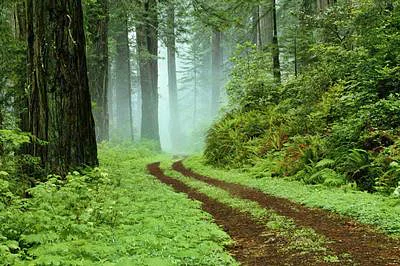Every Indian state I have been too has always been full of surprises and mesmerising experiences. People, Cultures, Culinary Delicacies, and above all the weather has been on top of the list while preparing itineraries to visit a country. I am indeed delighted to share a glimpse of my latest visit to the State of Tripura.
Tucked away in the northeastern corner of India, Tripura is a land of hidden treasures waiting to be discovered by avid travellers. From its rich cultural heritage to its stunning natural landscapes, this lesser-explored state offers a unique blend of history, tradition, and beauty. Tripura’s cultural tapestry is woven with the threads of diverse indigenous tribes, each with its own traditions, languages, and festivals. The state celebrates its vibrant heritage through various colourful festivals that give visitors a peek into the lives of its people.

History
Delving into the historical aspect of Tripura, the rock carvings at Debtamura offer a glimpse into the past. These prehistoric carvings etched on the cliffs date back thousands of years and depict scenes of daily life, animals, and deities. The intricate carvings serve as a testament to the artistic expressions of our ancestors and provide a link to the cultural heritage of the region.

Festivals
One of the most prominent celebrations in Tripura is the Hornbill Festival, held annually in December and started in 2020. Named after the state bird, this festival showcases the rich culture and traditions of the indigenous communities. Vibrant dance performances, traditional music, arts and crafts exhibitions, and local delicacies create an atmosphere of joy and camaraderie. The festival is a kaleidoscope of tribal life, and visitors can immerse themselves in the diverse traditions that come together in a harmonious celebration.

Architecture
Ujjayanta Palace, situated in the heart of Agartala, is a visual treat that reflects a blend of Mughal and European architectural styles. The palace, now a museum, takes visitors on a journey through time with its well-preserved artifacts, portraits, and exhibits that narrate the history of Tripura’s royalty. The sprawling gardens and regal interiors offer a glimpse into the opulence of a bygone era.

Natural Beauty
Tripura’s scenic landscapes and natural wonders are equally captivating, providing a refreshing contrast to its cultural riches. Floating serenely on Rudrasagar Lake, Neermahal is a magnificent palace that seems to emerge from a fairy tale. Often referred to as the “Lake Palace,” Neermahal was built in the 20th century and blends Hindu and Islamic architectural elements. Surrounded by water and adorned with intricate carvings, this palace is a visual delight. A boat ride to Neermahal offers a surreal experience and reveals the grandeur of this unique masterpiece.
Lakes
Tripura boasts two tranquil lakes that are a feast for the eyes. Rudrasagar Lake is not only the backdrop to the enchanting Neermahal but also a habitat for migratory birds during winter, making it a haven for birdwatchers. Dumboor Lake, on the other hand, stretches across a vast area, inviting visitors to boat and explore its serene surroundings. These lakes are not just bodies of water; they are reflections of nature’s beauty.
Mountaineering
For those seeking a serene escape, Jampui Hills offers breathtaking views of sunrise and sunset amidst cool temperatures. The hill station is dotted with orange orchards and offers panoramic vistas of the surrounding valleys. Trekking through Jampui Hills is an opportunity to connect with nature and witness the simplicity of rural life.
Wildlife
Nature enthusiasts and wildlife lovers will find their haven in the Sepahijala Wildlife Sanctuary. Home to a wide variety of flora and fauna, including primates, reptiles, and migratory birds, this sanctuary is a paradise for ecotourism. The sanctuary also features a zoo and a botanical garden, making it an educational and enjoyable experience for visitors.

Paradise for Food Lovers
A trip to Tripura is incomplete without savouring its culinary delights. Tripuri cuisine is a testament to the state’s diverse indigenous tribes. From bamboo shoot-based dishes to local herbs and spices, the food is a celebration of simplicity and flavours. The traditional fish stew known as “Mui Borok” and the spicy chutney “Tathu” are must-try delicacies that will leave your taste buds tingling. Beyond the attractions, what truly sets Tripura apart is the warm hospitality of its people. A visit to the state is an opportunity to interact with the locals, learn about their way of life, and forge lasting connections.
To conclude, I would like to say that Tripura, often overshadowed by its more popular northeastern counterparts, is a hidden gem waiting to be explored. From its vibrant festivals to its natural wonders, the state offers a unique blend of culture and nature that leaves a lasting impression.
A journey through Tripura is not just about sightseeing; it’s about experiencing the heart and soul of a region that is as diverse as it is beautiful.



